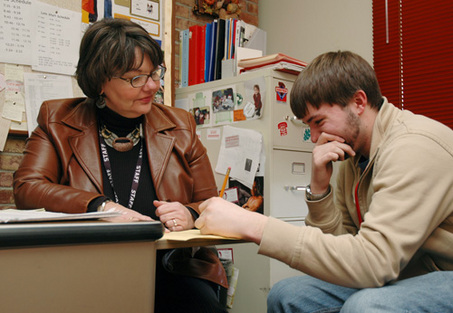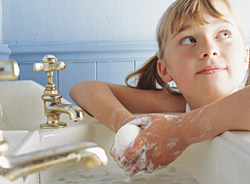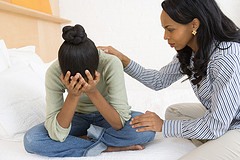
Is your teen getting terrifying thoughts, trying to get rid of something fearful, making extra sure that things are safe, clean or right? Someone with OCD gets very strong urges to perform certain rituals again and again, compulsorily. It might be getting difficult for your teen to explain why they perform such rituals by saying, “Just because…” But by performing those rituals, they simply get rid of their anxiety. They want to feel totally certain that something bad would not happen.
A few signs that you should look for to identify the onset of the disorder are:
- A prevailing fear that something bad will happen.
- Chapped hands from constant washing.
- Checking, rechecking and again checking, if a certain task is done.
- Unusually high usage of soap or paper towels.
- Answering the same question again and again.
Read through to figure out a few steps that are already tested, proven and in use to deal with the symptoms of OCD, will help you to deal with your kid’s disorder.
Make your child confide in you
You should always remember that OCD is never your kid’s fault, it is just a disorder. After your kid gets into his/her treatment of OCD, it is very important that you, as being parents, participate in it full time. You should try and learn more about the disorder from various sources, be supportive of your kid and modify your expectations so as to suit your kid’s symptoms. Teens with OCD would get better at different paces. So try and avoid comparisons on a day to day basis. Try to recognize and appreciate any improvement that shows in bits. Try to praise your teen’s efforts. In this way, the kid would in a way confide in you and would not feel left out in the crowd. For your teen, it would be becoming difficult to be accepted in other places like his/her institution, friend circle, etc. Once he/she confides in you, it would be easier for him/her to open up and share the problems with you. That would in return help you in helping him/her get over the disorder.
Find a friendly therapist
Finding the right kind of therapist for your kid is the most important thing. The therapist should know how to treat OCD well. He/she should be good with his/her job. Adding to that, he/she should also be a nice human being. He/she should understand reality, teens and feelings well. The therapist should be friendly to your kid. It is very important for the therapist to strike the right balance between try to help without trying very hard to force things on the sufferer. The therapist should understand that it is not an easy job to perform for the patient. The therapist should not be telling your kid that he/she is not putting enough efforts; else your kid might get hurt and get demoralized. The behavior of the therapist should be such that your kid does not get demotivated for trying to come over his/her obsessions.
Challenge compulsive thoughts and actions
Psychiatrist Jeffrey Schwartz has offered the following four steps for conquering the symptoms of OCD.
a. Re-label: Make your kid to recognize that the thoughts, worries, urges, obsessions are a result of OCD completely. He/she should be able to tell himself/herself that he/she does not feel the need to wash his/her hands but he/she is just having a compulsive urge to perform the ritual of washing his/her hands.
b. Re-attribute: Realizing that the intensity of the urge might be connected to a biochemical imbalance of the brain. He/she should tell himself/herself that it is not his/her but it is his or her OCD to remind himself/herself that the urges are just false signals from the brain.
c. Re-focus: Make your kid to shift his/her focus by paying extra attention to something else, for a few minutes at least. She/he should tell herself/himself that he/she is just experiencing a symptom of OCD; he/she needs to perform another behavior.
d. Re-value: The urges are not significant in oneself. He/she should tell himself/herself that it is just his/her stupid obsession and it has no importance. That’s just the brain. There is no need of paying attention to it.
Cognitive behavioral therapy
Cognitive behavioral therapy (CBT) for obsessive compulsive disorder (OCD) consists of two things:
a. Exposure and response prevention (ERP): It deals with providing repetitive exposure to the source of obsession. Your kid is made to avoid performing the compulsive behavior that he/she would regularly do to lessen the anxiety. If your kid is obsessed with washing his/her hand, he/she would be made to touch the door knob of a public toilet and would be made to sit without letting him/her to wash his/her hands. After sitting for a while with the anxiety, the urge will eventually start to go away on its own. He/she, here, would learn that there is not a need of a habit to get rid of the anxiety and he/she has some control over his/her obsessive thoughts and compulsive behaviors.
b. Cognitive therapy: It has its focus set on the disastrous thoughts and overstated sense of liability felt by your kid. A major part of cognitive therapy is to teach your kid strong and efficient conducts of responding to obsessive thoughts without giving into the compulsive behaviors.
Confronting and writing down your worries
Your kid should start to confront all the worries, thoughts, obsessions and compulsions. When he/she starts to obsess, it should be made sure he/she writes down all his/her thoughts on a writing pad, a laptop, a tablet or smart phone.
- The aim should be to keep a record of exactly what he/she is thinking, even if the same urges are repeated again and again. He/she should keep writing as and when the OCD urges keep on persisting.
- He/she would be able to figure out how repetitive his/her urges are.
- The similar urges when written down umpteen numbers of times might happen to lose their power over a certain period of time.
- Just thinking over the urges again and again is a much simpler process that writing them down. Writing the urges down is one heck of a work. It is very much likely that the obsessive thoughts would start to disappear once he/she gets on to writing them all down.
Healthy lifestyle habits
A balanced lifestyle plays a very important role in helping to keep the OCD behaviors away.
a. Healthy food habits: Your kid’s day should begin with breakfast and should go on with frequent small meals all through the day. Not eating for too long can lead to low blood sugar that increases the level of anxiety. Lot of complex carbs should be taken. They help stabilize the blood sugar and boost serotonin which is a neurotransmitter that has calming effects.
Alcohol and nicotine should be avoided. Alcohol lessens anxiety for a temporary period, but it causes anxiety as it wears off. The same way, cigarettes might seem like they are calming but nicotine is a stimulant that is very powerful in real.
b. Regular exercise: Exercise is an innate and efficient way of controlling OCD symptoms and it helps to refocus the thoughts when obsessions and compulsions pop up. Aerobic exercises for at least 30 minutes in a day help to get rid of stress and release endorphins which are the feel good chemicals of the brain.
c. Adequate sleep: As insomnia is caused by anxiety and worries, similarly lack of sleep could trigger anxious thoughts. Adequate amount of rest helps in maintaining the emotional balance.
Create an OCD worry period
Instead of trying to suppress the obsessions and compulsions, the practice of postponing them should be developed.
- Ask your kid to schedule one or two worry periods of 15 minutes each every day. This would be the time that your kid would dedicate to obsessing. Set a time and place like, in the bedroom from seven o’clock to 15 minutes past seven in the morning and six o’clock to 15 minutes past six in the evening.
- When your worry period is on, your kid should focus only on his/her urges or the negative thoughts. Your kid should not be trying to correct those. By the end of the period, he/she should take some calming deep breaths, letting the urges go away and should be able to return to the normal activities. The rest of the day should be without obsessions and compulsions.
- If urges happen to come during the rest part of the day, they should be written down and postponed to the worry period.
- During the worry period, your kid should go over the list and indulge in obsessing with the written down worries of the day.
Medications or drug therapy
Selective serotonin reuptake inhibitors (SSRIs) like paroxetine, sertraline, fluvoxamine, fluoxetine, escitalopram and the tricyclic-antidepressants like clomipramine are the most commonly used medications. SSRIs check the pumping back of excess serotonin into the original neuron which released it. Serotonin could help bind to the receptor sites of the neurons nearby and send chemical signals that could regulate the excessive anxious and obsessive thoughts. In some cases where resistance from treatment occurs, an amalgamation of a clomipramine and an SSRI has proven to be effective even when none of the drug individually shows any effectiveness. Benzodiazepines are also used sometimes, even though they are believed to be ineffective usually. The atypical antipsychotics such as quetiapine, olanzapine and risperidone also act supportive to an SSRI in treatment-resistant OCDs. These drugs, however, are often badly tolerated and show remarkable metabolic side effects.
Tips for parents
There can be a big impact in the way you just react to your kid’s symptoms.
- No negative comments or criticism: Keep your focus on your kid’s positive qualities. A supportive environment could improve the result of the treatment.
- No scolding: You should not scold your kid while asking him/her to stop his/her repetitive habits. The mental pressure shall only make it worse. Just keep in mind that the behavioral patterns are just symptoms not flaws in the character.
- Be patient: Your kid would take his/her time to overcome the problems. Applaud the attempts to resist OCD.
- Do not support the rituals: You should be supportive of the person, not their obsessions. Supporting the obsessive behaviors would act as reinforcement.
- Have a pact to not let OCD take over your family: Keep your family life as normal as it can be so as to have a low-stress environment at home.



